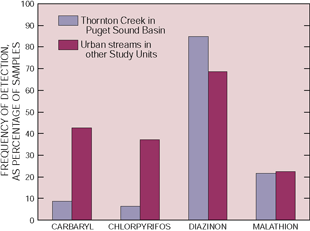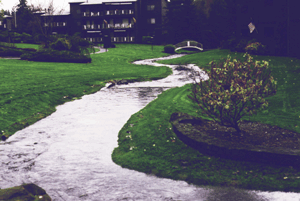MAJOR FINDINGS
Pesticides in Surface Water Were Indicative of Upstream Land Uses, and More Pesticides Were Detected in Streams Than in Rivers
Twenty-nine pesticides were detected in Fishtrap Creek, which drains an agricultural area in the Nooksack River Basin (see map, p. 20), compared with 21 in Thornton Creek, an urban stream. In Fishtrap Creek, the more frequent detections of the herbicides atrazine and metolachlor, used more in agricultural areas, and less frequent detections of the herbicides dichlobenil and prometon (fig. 6), used more in urban areas, are consistent with the predominant land use in the drainage basin. Urban-use pesticides in Fishtrap Creek are probably transported from urban areas in the upper and lower parts of the basin.
The two large rivers sampled for pesticides, the Nooksack and Duwamish (see map, p. 20), integrate land-use effects. The herbicides prometon, simazine, and tebuthiuron, which are used in urban settings, were detected frequently in the Duwamish River (fig. 6). This is indicative of the urban land use surrounding and immediately upstream from the sampling site. Metolachlor, an agricultural herbicide, was detected more often in the Duwamish River than in the Nooksack River, which was sampled in an agricultural setting. Metolachlor in the Duwamish River was likely transported from agricultural areas upstream from the mostly urbanized lower part of the basin, where samples were collected.
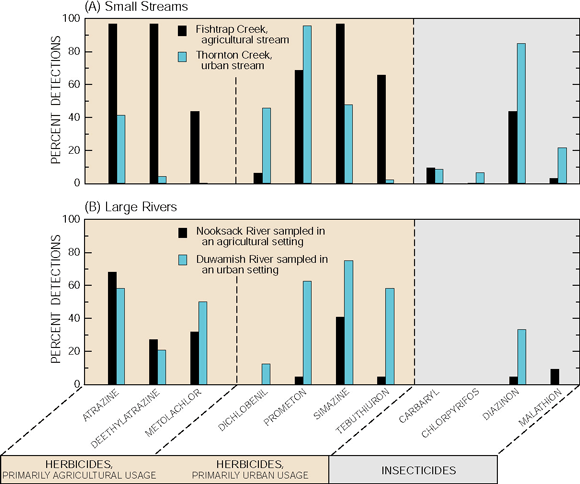 |
| Figure 6. Pesticides detected in small streams (A) and large rivers (B) were indicative of land use, but detection frequencies in large rivers were lower because of dilution by flows from forested headwaters. |
Pesticides transported to the Nooksack and Duwamish Rivers are diluted by the volume of high-quality water from forested head-waters, resulting in lower detection frequencies compared with Fishtrap and Thornton Creeks (fig. 6). In addition to lower detection frequencies, fewer pesticides were detected in the large rivers.
Diazinon was the most frequently detected insecticide in both small streams and large rivers (fig. 6). It is used heavily in urban areas of the Puget Sound Basin, and its frequent detection, sometimes at concentrations exceeding the chronic guideline for the protection of aquatic life (table 1), prompted a more focused study of pesticides in urban streams in Seattle and surrounding King County (see below).
|
Table 1. Concentrations of three insecticides were sometimes above chronic guidelines for the protection of aquatic life |
||||
|
Insecticide |
Aquatic life guideline (micrograms |
Percentage of all samples exceeding guideline |
Site
in exceedance and |
Range of concentrations detected at the site (micrograms per liter) |
|
Chlorpyrifos |
0.041 |
1 |
Thornton (2) |
0.006-0.074 |
|
|
|
|
|
|
|
Diazinon
|
0.08 |
9 |
Thornton (20) |
0.003-0.501 |
|
|
|
|
|
|
|
Lindane |
0.01 |
1 |
Thornton (2) |
0.02 |
|
1U.S. Geological Survey, 1999a. |
||||
Concentrations of Pesticides in Surface Water Draining Urban and Agricultural Areas Sometimes Exceeded Guidelines for the Protection of Aquatic Life
The insecticides chlorpyrifos, diazinon, and lindane were sometimes detected at concentrations above chronic guidelines for the protection of aquatic life (table 1). Concentrations of diazinon exceeded its guideline in 9 percent of all samples, and in Thornton Creek, concentrations exceeded the guideline in 20 percent of samples. It is estimated that about half the 83,000 pounds of diazinon applied annually in the Puget Sound Basin are applied in King County (Tetra Tech Incorporated, 1988). Diazinon is the insecticide purchased most frequently by King County residents (fig. 7).
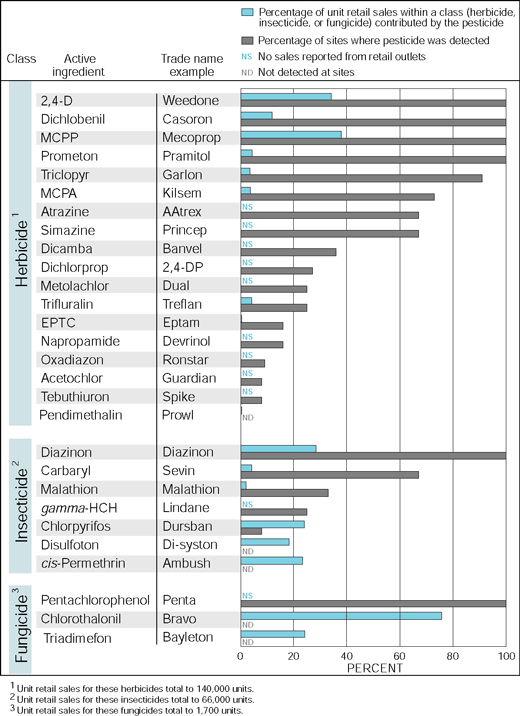 |
| Figure 7. A comparison of pesticides detected in urban streams with retail sales data suggests that homeowner and nonresidential applications both are sources of pesticides in streams. Sales were reported in units, which represent a bag, bottle, or other package containing the pesticide. |
Pesticides Applied to Lawns and Gardens, As Well As Those Applied in Nonresidential Areas, Are Sources of Pesticides in Urban Streams
Because of the prevalence of diazinon and other pesticides in Thornton Creek, the USGS collaborated with the Washington State Department of Ecology and the King County Hazardous Waste Management Program to study pesticides in streams in 10 urban and suburban watersheds in King County (see map, p. 20). Samples were collected during April and May 1998 when retail sales of pesticides are highest (Voss and others, 1999), and they were collected during storms when runoff can transport pesticides to streams.
Because USGS and Washington State Department of Ecology laboratories both participated in the study, additional pesticides not included in the NAWQA study were analyzed. To help determine sources of pesticides detected, King County provided sales data for pesticides sold in 10 large home and garden stores during 1997.
Twenty-three of 98 pesticides analyzed for were detected in the urban streams. Homeowner use as a source of pesticides in streams is indicated for compounds like the herbicide 2,4-D and the insecticide diazinon, which were detected in all streams and were sold frequently in the home and garden stores (fig. 7). Some pesticides sold in stores were not detected in streams, indicating that other factors, like the rate at which a compound breaks down, affect the relation between usage and detection.
Almost half of the pesticides detected in the streams had no retail sales, indicating that they are usually not applied by homeowners. In urban areas, pesticides are also applied in commercial areas, along road rights-of-way, and in parks and recreational areas.
|
Throughout the Nation, the insecticides diazinon, carbaryl, chlorpyrifos, and malathion were detected much more frequently in streams draining urban basins than in streams draining agricultural basins (U.S. Geological Survey, 1999b). Except for carbaryl, these pesticides also were detected more frequently in Thornton Creek, an urban stream, than in Fishtrap Creek, an agricultural stream (fig. 6). Detection of these pesticides is related to usage. For example, diazinon and chlorpyrifos, which nationally rank 1 and 4 among insecticides used for homes and gardens, rank 1 and 2 in unit sales of insecticides sold by home improvement stores in urban and suburban areas of King County (fig. 7). Insecticides in streams are a concern because even at relatively low concentrations they can exceed guidelines for the protection of aquatic life (table 1).
|
Historically Used Pesticides and PCBs Are Still Detected in Streambed Sediments and Fish Tissue
Streambed sediment and whole fish (sculpin, a bottom fish) tissue were analyzed at sites throughout the basin (see map, p. 20) in 1995 for organochlorine pesticides and PCBs. These compounds have been shown to have negative impacts on the health of aquatic organisms as well as the organisms that consume them. More organochlorine compounds were detected in both streambed sediments and fish tissue at sites surrounded by agricultural and urban land uses than at sites in undeveloped, forest, or mixed- land-use areas (fig. 8).
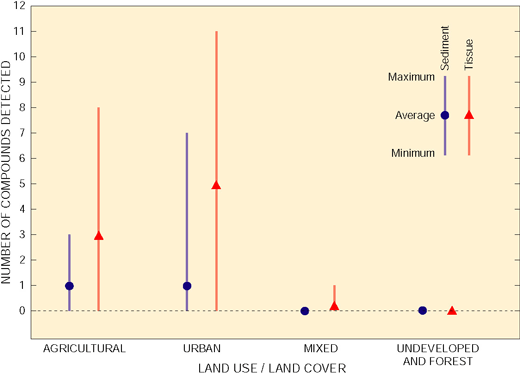 |
| Figure 8. Organochlorine compounds, including the insecticide DDT and PCBs, in streambed sediments and fish tissue were primarily detected in urban and agricultural streams. |
Fish Tissue Contamination is Related to Urban and Agricultural Land Uses
The relation between land use and the probability of detecting organochlorine compounds in fish (sculpin) tissue were statistically significant. This relation suggests that urban and agricultural land uses both contribute to the probability that a fish is contaminated with organochlorine pesticides. The probability of detecting total PCBs in fish was significantly related to urban land use only (Black and others, 2000). These relations also suggest that there is a land-use threshold below which the probability of finding organochlorine compounds in fish tissue is unlikely (fig. 9).
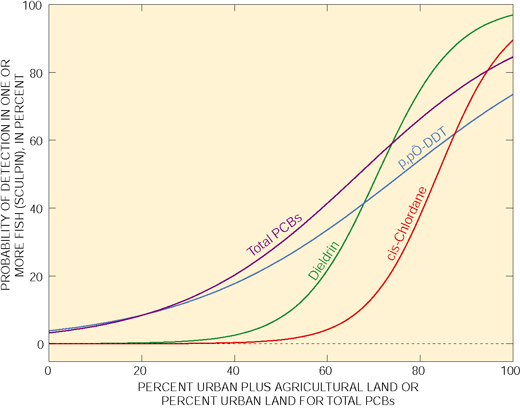 |
| Figure 9. The probability of detecting specific organochlorine compounds in one or more fish (sculpin) at a site increased with the percentage of urban and agricultural land in the drainage basin. Dieldrin, cis-Chlordane, and p,p’-DDT relations are based on the percentage of agriculture plus urban land upstream from the sampling site. The total PCBs relation is based on the percent of urban land upstream from the sampling site. |
Organochlorine Compounds in Streambed Sediment and Fish May Be a Concern for Aquatic Ecosystems
Organochlorine pesticides were detected in streambed sediment at 3 of 19 sites (fig. 10). At Thornton Creek, an urban stream, levels of DDE (a breakdown product of DDT) and DDT exceeded the Canadian Council of Ministers of the Environment’s (Canadian Council of Ministers of the Environment, 1995) probable effects level (PEL). Compounds exceeding the PEL are likely to result in adverse effects on aquatic organisms. It is important to note that levels of DDT in Thornton Creek sediment were higher than either one of its breakdown products, DDD and DDE. This may indicate that land disturbances in the basin have reintroduced buried soils contaminated with DDT.
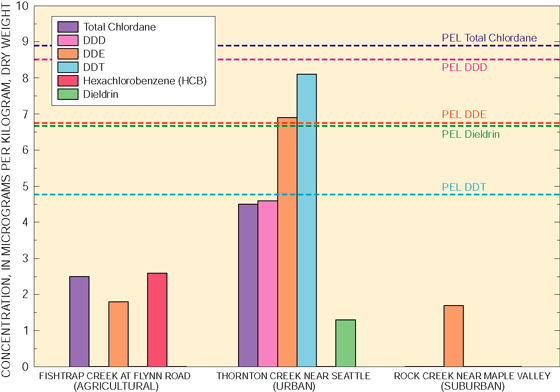 |
| Figure 10. Concentrations of organochlorine compounds in streambed sediment in the Puget Sound Basin sometimes exceeded Canadian probable effects levels (PELs). Compounds above the PELs may have negative impacts on aquatic organisms. |
Organochlorine compounds were also detected in the tissue of whole bottom fish (sculpin) collected at 8 of 18 study sites (fig. 11). The largest number and highest concentrations of these compounds were in the fish collected from urban sites. At some sites, total PCBs and DDT concentrations were equal to or above the New York State Department of Environmental Conservation (NYSDEC) criteria for the protection of fish-eating wildlife (Newell and others, 1987).
Generally, the concentrations of organochlorine compounds in sediment and fish tissue were in the middle 50 percent nationally (see Appendix). Occasionally, concentrations of DDE, total chlordane, and total DDT were in the upper 25 percent of those reported nationally.
 |
| Figure 11. Concentrations of organochlorine compounds in fish (sculpin) tissue from streams in the Puget Sound Basin sometimes exceeded New York State Department of Environmental Conservation (NYSDEC) criteria. Concentrations above criteria may have a detrimental effect on fish-eating organisms. |
 |
| Whole sculpin (Cottus) were analyzed for organochlorine compounds. (Photograph by Ward W. Staubitz, U.S. Geological Survey.) |
|
Characteristics and historical uses of organochlorine compounds detected in Puget Sound Basin fish tissue and streambed sediment Organochlorine compounds are synthetic organic compounds containing chlorine. As generally used, the term refers to compounds containing mostly or exclusively carbon, hydrogen, and chlorine. Examples include organochlorine insecticides, polychlorinated biphenyls, and some solvents containing chlorine. Chlordane (Octachloro-4,7-meth-anotetrahydroindane) is an organochlorine insecticide no longer registered for use in the United States. Technical chlordane is a mixture in which the primary components are cis- and trans-chlordane, cis- and trans-nonachlor, and heptachlor. DDT (Dichloro-diphenyl-trichloro-ethane) is an organochlorine insecticide no longer registered for use in the United States. Dieldrin is an organochlorine insecticide no longer registered for use in the United States. It is also a breakdown product of the insecticide aldrin. Heptachlor epoxide is a breakdown product of the organochlorine insecticide heptachlor. It was used in the United States until the 1970s. Hexachlorobenzene (HCB) is a fungicide used as a seed and soil treatment. It was discontinued from use in the United States in the 1980s. Polychlorinated biphenyls (PCBs) are a mixture of chlorinated derivatives of biphenyl, marketed under the trade name Aroclor with a number designating the chlorine content (such as Aroclor 1260). PCBs were used in transformers and capacitors for insulating purposes and in gas pipeline systems as a lubricant. Further sale for new use was banned by law in 1979. |
Streams and Rivers in Developed Areas Were Enriched with Nutrients Relative to Those in Undeveloped Areas
The highest average concentrations of total nitrogen were in small streams draining agricultural areas. The concentrations were nearly twice those in streams draining urban areas and over 40 times the average concentrations in streams draining undeveloped land (table 2). Drainage basins in agricultural areas also yielded the most nitrogen per square mile (fig. 12). Concentrations and yields of total nitrogen in Puget Sound Basin streams and rivers correlate with usage and atmospheric deposition of nitrogen in drainage basins (Inkpen and Embrey, 1998). Fertilizers used in both agricultural and urban areas, manure associated with dairy farms, and atmospheric deposition are sources of nitrogen in Puget Sound Basin rivers (Embrey and Inkpen, 1998).
|
Table 2 . Highest average concentrations of total nitrogen were in streams draining agricultural areas. Average concentrations of total phosphorus exceeding the USEPA desired goal of 0.1 mg/L to prevent excessive plant growth (shown in bold) were present in streams in urban, agricultural, and forested basins |
||||
|
River or stream |
Average total nitrogen concentration (milligrams per liter) |
Average total phosphorus concentration |
Basin area size |
Land use/land cover (dominant land use in mixed)1 |
|---|---|---|---|---|
|
Fishtrap |
3.54 |
0.086 |
small |
agricultural |
|
Newaukum |
2.82 |
0.210 |
small |
agricultural |
|
Thornton |
1.73 |
0.131 |
small |
urban |
|
Big Soos |
1.20 |
0.054 |
small |
urban |
|
Springbrook |
1.10 |
0.165 |
small |
urban |
|
Nooksack, Brennan |
0.66 |
0.301 |
large |
mixed (agricultural) |
|
Duwamish |
0.65 |
0.089 |
large |
mixed (urban) |
|
Nooksack, North Cedarville |
0.39 |
0.152 |
large |
mixed (forest) |
|
Skokomish |
0.13 |
0.078 |
large |
mixed (forest) |
|
North Fork Skokomish |
0.07 |
0.012 |
small |
undeveloped |
|
Green |
0.07 |
0.012 |
small |
forest |
|
1 Forest land that is not logged is designated undeveloped. In basins with mixed land use, the land use in the part of the basin where samples were collected is usually considered the dominant land use. |
||||
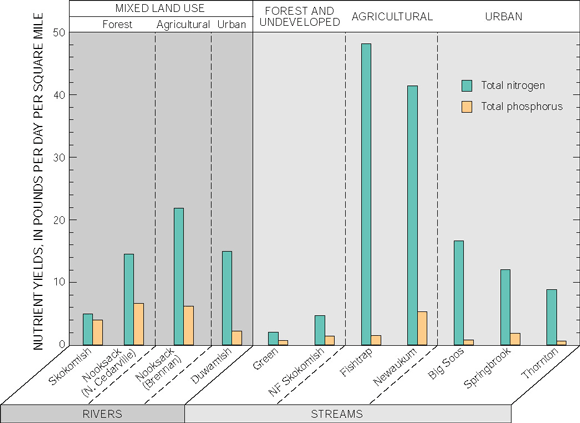 |
| Figure 12. Basins in agricultural areas yielded the most nitrogen per square mile. The forested area upstream from the Nooksack River at North Cedarville yielded the most phosphorus. In basins with mixed land use, the dominant land use is indicated. The Green River above Twin Camp Creek and North Fork Skokomish River fall into the stream category because their drainage basins are relatively small. |
Concentrations of Phosphorus in Some Streams and Rivers May Promote Excessive Plant Growth
Average concentrations of total phosphorus exceeding the USEPA desired goal of 0.1 mg/L to prevent excessive plant growth were detected in streams and rivers in all land-use areas except undeveloped land (table 2). Unlike total nitrogen, concentrations of total phosphorus in streams and rivers in the Puget Sound Basin do not correlate with usage and atmospheric deposition of phosphorus in drainage basins (Inkpen and Embrey, 1998). This is because phosphorus attaches to soil particles and usually remains close to application areas unless it is transported to rivers by soil erosion.
Because of the importance of erosion in transporting phosphorus to streams, yields of total phosphorus correlate with yields of suspended sediment. The highest yields of both suspended sediment and total phosphorus were in the Nooksack River at North Cedarville, which drains a forested area.
Erosion of unstable streambanks and landslides transport sediment and phosphorus to headwater streams in the Nooksack River Basin. Most of the unstable streambanks are associated with road construction and logging (U.S. Forest Service, 1995).
Concentrations of Nitrate and Phosphorus in Streams and Rivers Have Not Changed or Have Only Slightly Increased with Time
Concentrations of nitrate, one of the major forms of nitrogen in water, and of total phosphorus have not changed much over the period 1980 to 1997 in several Puget Sound Basin rivers and streams (fig. 13). In three streams, nitrate concentrations have increased by a small amount, 0.014 mg/L per year or less. Only in Newaukum Creek did concentrations of both nitrogen and phosphorus increase over time. Although data were not collected to determine the cause, trends often reflect land-use changes. For example, urban development might be a factor related to increasing nitrate concentrations in Big Soos Creek and in Newaukum Creek, which drains an agricultural basin with hobby farms and residential development.
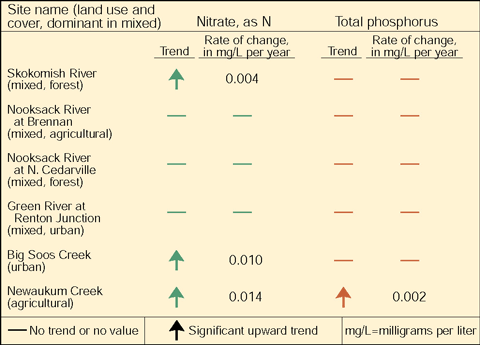 |
| Figure 13. In three of six rivers and streams monitored by the Washington State Department of Ecology and King County, nutrient concentrations have remained stable from 1980 to 1997. In three others, concentrations of nitrate have gradually increased with time. |
Runoff During Rainstorms Contributes Contaminants to Streams, Indicating Nonpoint Sources
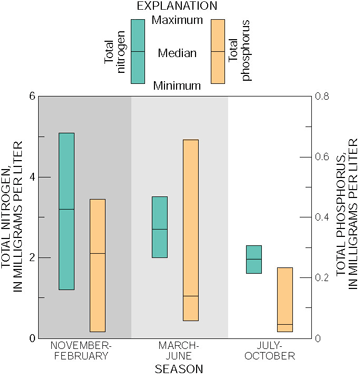 |
| Figure 14. Nutrient concentrations in Newaukum Creek were highest during the rainy winter and spring periods. Concentrations were lowest during late summer-early fall when rainfall amounts are lowest. |
Washoff of nutrients and pesticides during storms causes both seasonal and short-term temporal variations in concentrations. A typical seasonal pattern for Puget Sound Basin streams and rivers is illustrated by lower concentrations of nitrogen and phosphorus in Newaukum Creek from July through October when rainfall amounts are lowest (fig. 14).
Commonly used pesticides, such as diazinon, often had higher concentrations during rainstorms when they were washed off from areas of application (fig. 15). Even when daily rainfall amounts were small, less than 0.05 inch, diazinon concentrations increased in Thornton Creek.
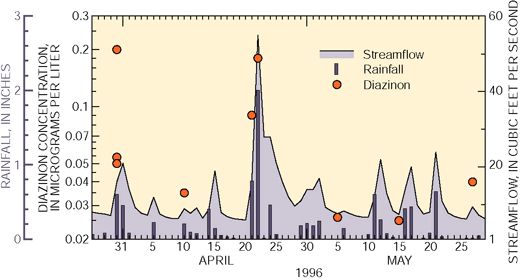 |
| Figure 15. Peak concentrations of diazinon in Thornton Creek often occurred during spring rainstorms, which can produce an inch or more of rain in a day. |
| Table of Contents || Previous Section || Next Section || Glossary U.S. Geological Survey Circular 1216 Suggested citation:
|


